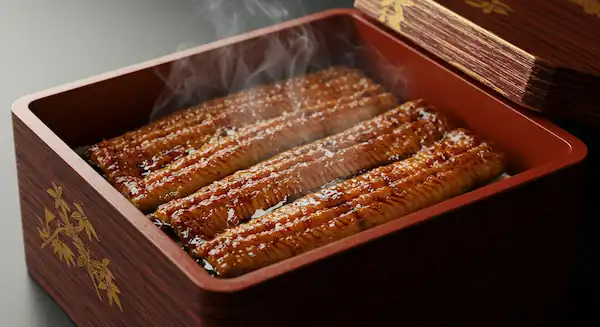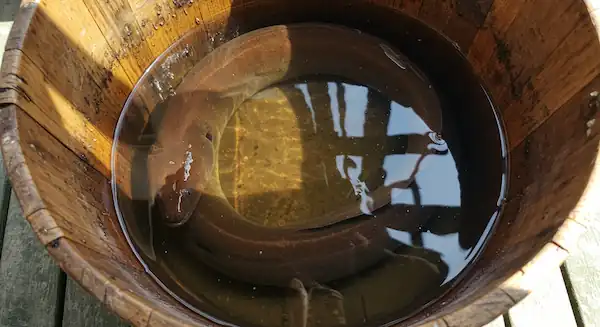History, Nutrition, Enduring Love, and Global Perspectives
Deeply rooted in ancient Japanese culinary traditions, “unagi” (freshwater eel) continues to captivate countless people.
It especially graces dining tables as a quintessential Japanese summer experience on “Doyo no Ushi no Hi” (Midsummer Day of the Ox).
One bite, and anyone would be enchanted by its rich aroma and flavor. However, it’s also known as a luxury ingredient, and enjoying it regularly might require a bit of courage (and budget!).
This article delves into the profound world of unagi: why Japanese people love it so much, the origins of eating it on Doyo no Ushi no Hi, its historical background, surprising nutritional value, reasons for its high price, and even reactions from beyond Japan’s shores.
Table of Contents
The Tradition of “Doyo no Ushi no Hi”: A Historical Summer Stamina Source
Eating unagi on “Doyo no Ushi no Hi” is an indispensable summer custom in Japan.
When and how did this practice begin?
“Doyo” refers to one of the miscellaneous seasonal markers indicating the change of seasons, derived from the ancient Chinese five-element theory (the idea that all things are composed of five elements – wood, fire, earth, metal, and water – which influence each other in a cyclical manner).
It specifically denotes the approximately 18-day period just before the traditional start of spring (Risshun), summer (Rikka), autumn (Risshu), and winter (Ritto). “Ushi no Hi” is the Day of the Ox according to the Chinese zodiac.
Several theories exist regarding how the custom of eating unagi on the Doyo no Ushi no Hi during summer spread.
The most famous involves Hiraga Gennai, an inventor from the Edo period (1603-1868).
Legend has it that an unagi restaurant struggling with slow summer sales consulted Gennai.
He suggested they display a sign reading, “Today is Doyo no Ushi no Hi.”
This marketing ploy was a huge success, drawing crowds.
As customers, intrigued by the unusual phrasing, stopped by, the owner, armed with Gennai’s promotional lines, lured them in.
Other unagi restaurants soon followed suit, and the custom took root.
Another theory attributes the origin to Shokusanjin (Ōta Nanpo), an Edo-period poet and satirist.
He supposedly created a kyōka (comic tanka poem) for an unagi restaurant, advertising that eating unagi on the Day of the Ox would ward off illness.
However, the connection between unagi and summer health dates back even further, to the Nara period (710-794). The Man’yōshū, Japan’s oldest poetry anthology, contains a poem recommending unagi to someone suffering from summer fatigue.
This suggests unagi was recognized as a health food for combating summer lethargy even then.
The preparation at the time was simple: chunks of eel were skewered, grilled, and seasoned with salt or sansho (Japanese pepper) miso.
Thus, unagi has long played a role as a stamina-boosting food supporting Japan through its summers.
A Nutritional Treasure Trove: The Amazing Health Benefits of Unagi
The belief that unagi helps prevent summer fatigue is well-founded, thanks to its outstanding nutritional profile.
Unagi is practically an “edible nutritional drink,” packed with essential nutrients our bodies need.
Let’s look at the main nutrients in unagi and their functions:
- Vitamin A
Boosts immunity and maintains the health of eyes and mucous membranes.
Just 100g of unagi can provide the adult daily requirement.
Being a fat-soluble vitamin, it’s efficiently absorbed with the eel’s natural fats.
However, excessive intake should be avoided. - B Vitamins (B1, B2)
Vitamin B1 aids in carbohydrate metabolism and is effective for fatigue recovery.
Vitamin B2 helps convert fats, carbohydrates, and proteins into energy and maintains healthy skin, hair, and nails.
A deficiency in these vitamins can lead to fatigue and poor concentration, but unagi is rich in them. - Vitamin D
Helps absorb calcium, strengthening bones and teeth.
It’s particularly beneficial in preventing osteoporosis, common in older adults. - Vitamin E
A powerful antioxidant, it’s expected to prevent cell aging and improve blood circulation. - DHA (Docosahexaenoic Acid) & EPA (Eicosapentaenoic Acid)
These unsaturated fatty acids, commonly found in blue-backed fish, are also abundant in unagi.
They are known to improve blood flow, reduce bad cholesterol, and are believed to be involved in maintaining memory and cognitive function. - High-Quality Protein
Contains ample high-quality protein, essential for muscle repair and boosting immunity. - Minerals
Provides a good balance of minerals often lacking in modern diets, such as calcium, iron, and zinc.
These nutrients work synergistically, making unagi beneficial for recovering from summer fatigue, replenishing energy, and enhancing immunity.
Its tender flesh is also easy to digest, making it an ideal food for the elderly.
Irresistible Charm: Why Japanese People Adore Unagi
Why do so many Japanese people list unagi as one of their favorite foods?
Its appeal goes beyond mere nutritional value.
The taste, aroma, and texture that stimulate the five senses, along with its deep-rooted presence in Japanese food culture, are what truly captivate people.

The Art of Taste: Secret Sauce and Profound Umami
The defining taste of unagi kabayaki (grilled eel with sauce) comes from its sweet and savory “tare” sauce.
This sauce is typically made from soy sauce, mirin (sweet cooking wine), sugar, and other ingredients, but the exact recipe and method vary from shop to shop.
The “secret tare,” often continuously replenished and used for many years, is the very essence of a restaurant’s history and soul.
The harmony of the fragrant grilled eel and the rich, savory tare creates an exceptional sense of bliss in the mouth.
The initial burst of sweetness and umami, followed by the refreshing kick of sansho pepper cleansing the palate, is a culinary masterpiece honed over centuries.
An Appetite-Whetting Aroma: The Fragrance of Grilling
Have you ever found yourself stopping in your tracks, drawn by the irresistible smoky aroma wafting from an unagi restaurant?
The scent of unagi kabayaki, slowly grilled over charcoal, is a result of the Maillard reaction – a chemical reaction between amino compounds and sugars during heating, which creates its distinctive browned color and mouth-watering fragrance.
This aroma is a hallmark of Japanese summer.
Exquisite Texture: Kanto vs. Kansai Styles, Each with Its Own Dedication
The preparation of unagi kabayaki differs by region, leading to variations in texture.
The Kanto (Tokyo area) style involves grilling the eel plain (shirayaki), then steaming it before applying tare and grilling again.
This results in a plump, soft, and tender texture.
In contrast, the Kansai (Osaka/Kyoto area) style skips the steaming process, grilling the eel directly (jiyaki).
This yields a crispy, fragrant skin and a firmer, more substantial bite.
Both styles showcase the exquisite textures born from the skilled techniques of culinary artisans.
Unagi as Culture: A Feast for Special Occasions
Unagi transcends being just an ingredient; it’s deeply intertwined with Japanese culture and tradition.
Mentioned in the ancient Man’yōshū and enjoyed by commoners in the Edo period, it has also been a subject in literature and art, etching itself deeply into the Japanese psyche.
Even today, it’s cherished not only on Doyo no Ushi no Hi but also as a “hare no hi gochisō” – a special feast for celebrations and important occasions.
This might stem from unagi’s symbolism of stamina and a respect for a culinary culture passed down through generations.
The Price of Perfection: Why Unagi is a Luxury Ingredient
While delicious and nutritious, unagi is by no means cheap.
Why is it considered a luxury food? Several complex factors contribute to its high price.

Decline of Natural Resources and Difficulty of Aquaculture
The primary reason is the significant decrease in “shirasu-unagi” (glass eels), the fry of Japanese eel.
Japanese eels spawn near the Mariana Islands, and the hatched glass eels drift on ocean currents to the coasts of Japan.
However, due to environmental destruction and overfishing, their catch has been declining year by year.
Most farmed unagi currently available is raised from these wild-caught glass eels, as full-cycle aquaculture (raising eels from eggs to adulthood) is still commercially very challenging.
Therefore, the supply of glass eels heavily influences the price of farmed unagi, contributing to its persistently high cost.
The Japanese eel is also designated as an endangered species, and international resource management efforts also affect prices.
Time and Cost of Growth
It takes over a year for unagi to grow to a marketable size.
Aquaculture requires substantial costs for feed, water quality management, and labor, and the survival rate at farms is not particularly high, around 70%.
These rearing costs are reflected in the price.
Specialized Cooking Techniques and Dwindling Artisans
Preparing unagi involves specialized techniques such as “sakki” (cutting), “kushi-uchi” (skewering), “mushi” (steaming, in Kanto style), and “yaki” (grilling), all of which demand skilled craftsmanship.
However, the number of artisans possessing these advanced skills is declining, which also contributes to higher prices.
High Demand and Special Food Culture
Demand for unagi is extremely high, especially around Doyo no Ushi no Hi in summer, when prices tend to rise.
It’s also popular as a gift due to its reputation as a nourishing food, and its image as a feast for special occasions supports its price.
Complex Distribution and Environmental Factors
A complex distribution system, passing through multiple intermediaries from glass eel brokers to farmers, processors, wholesalers, and retailers, adds intermediate margins that affect the final price.
Furthermore, changes in river environments due to dam construction and embankment work, as well as shifts in ocean currents due to global warming, are also suspected to impact unagi habitats and migration.
These intertwined factors have established unagi as a luxury ingredient.
“UNAGI” Through Global Eyes: Impressing Foreign Palates with a Japanese Delicacy
Japanese unagi is now a focal point not only domestically but also for tourists from overseas.
“Unajū” (unagi kabayaki served in a lacquered box over rice) consistently ranks high among the “Japanese dishes I want to try” for foreign visitors.
So, what do they think of Japanese unagi?
In many cases, foreigners tasting Japanese unagi for the first time are deeply impressed by its deliciousness.
Praise like “Amazing!” or “The best fish I’ve ever had!” is common, and some even declare Japanese unagi to be the “most delicious in the world.”
They seem captivated by the anticipation upon opening the lid of the unajū box and the stunning transformation of the eel from its swimming form into a glistening, delectable feast.
For those from countries with their own eel-eating cultures, the Japanese preparation methods and seasonings can be a fresh experience.
For instance, in Germany, eel is often smoked.
The Japanese kabayaki style, with its sweet and savory tare, is perceived as a completely different and surprisingly delicious dish.
In the Netherlands, smoked eel (Gerookte paling) is also eaten, but they find Japanese tare-glazed kabayaki “looks delicious.”
Some Americans find Japanese unagi tare “too sweet, like caramel sauce,” which can be attributed to differences in culinary tastes.
In Spain, there’s a dish called “angulas al ajillo” made with baby eels simmered in garlic and oil, but the Japanese style of preparing larger eels as kabayaki is quite novel.
For people from countries where eating eel is uncommon, its very existence can be surprising, and they might initially hesitate to try it.
However, once they taste it, many become captivated by its charm.
In this way, Japanese unagi offers a new culinary experience to people worldwide, conveying the depth of Japan’s food culture.
A Must-Try When Visiting Japan: An Exquisite Dish Worth the Price
We’ve explored the history, nutrition, reasons for its popularity in Japan, its high cost, and foreign reactions to unagi.
While certainly not an inexpensive food, it’s an exquisite dish that you should definitely try if you have the chance to visit Japan.
Eating unagi is more than just satisfying hunger; it’s an experience that allows you to connect with Japan’s rich culinary culture and craftsmanship.
At long-established unagi restaurants, you’ll be served kabayaki grilled with masterly skill, using a secret tare passed down through generations.
Every bite is a condensation of history and tradition.
Even if it’s an unfamiliar ingredient, it’s well worth taking the plunge.
Its fragrant aroma, plump flesh, and the harmonious blend of sweet and savory tare will surely create an unforgettable taste memory.
Although expensive, this price reflects the meticulous skill of the artisans and the value of a scarce natural resource; it can be considered an investment in a special culinary experience.
A Timeless Japanese Treasure
The culture of eating unagi, epitomized by Doyo no Ushi no Hi, is more than just a custom; it’s a culinary art form packed with Japanese history, nutritional wisdom, and a passion for gastronomy.
Its price reflects contemporary challenges such as the decline of glass eels and the difficulties of aquaculture, yet its allure continues to draw people in.
Nutritious, deeply flavorful, and etched into the hearts of the Japanese people, unagi is a true treasure.
Given that the Japanese eel is an endangered species, it’s incumbent upon us to appreciate this blessing, protect the resource, and pass this wonderful food culture on to future generations.
When you visit Japan, please take the time to savor this dish, a condensation of the country’s history and culture.
It will surely be an invaluable experience that enriches your travel memories.
References
- Special Feature 2 Eels – Ministry of Agriculture, Forestry and Fisheries
- “Momoka Japan: What are the reactions of foreigners trying eel for the first time?
- My navi: List of nutritional components of eel! Explanation of fatigue recovery and beauty effects
- Food’s U: Explaining the nutritional value of eel and its beneficial effects on the body
- Food Media: Why is eel a luxury food? Learn about its history and eel dishes!









Leave a Reply